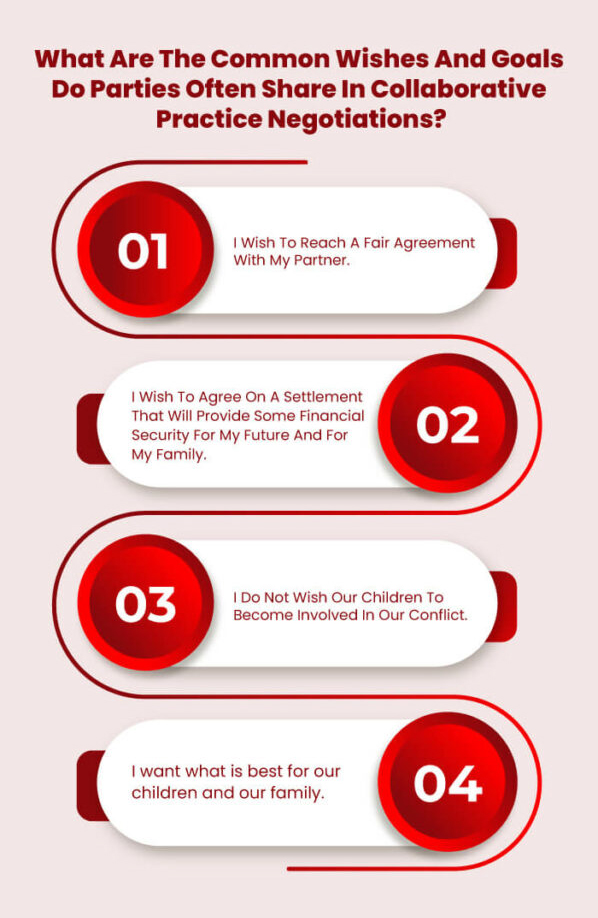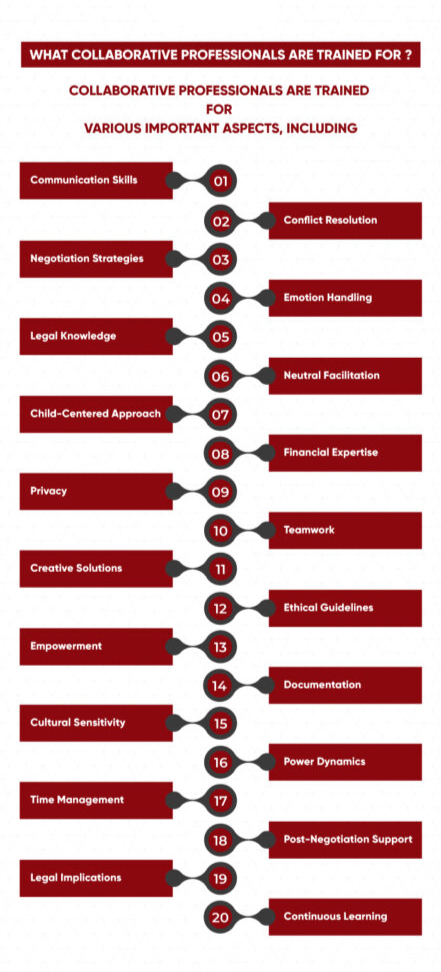Understanding Contributions in Family Law Property Settlements When a relationship ends, whether through separation or divorce, the question of who gets what becomes central. Property…

Collaborative Law in Australia

Since its emergence in 1990, the collaborative practice has been a rapidly growing family law practice throughout America, Canada, Europe, England and now Australia.
On 1 January 1990 Stuart Webb, a Family Lawyer in Minneapolis in the United States decided that he would henceforth represent his clients only pursuant to a binding agreement that neither he nor the lawyers for the other party would ever go to Court for their clients.
His sole purpose was to ensure that his client and his client’s partner were able to reach an efficient respectful and interest-based resolution on matters resulting from a breakdown in the clients’ relationship. Stuart Webb realized that he needed like-minded family lawyers to practice family law in this manner.
What is Collaborative Practice in family law QLD?
Collaborative law, also known as collaborative practice. Collaborative practice has now established itself as a prominent means of resolving family law disputes.
The core element of collaborative practice is that lawyers and their clients will not threaten to resort to or engage in litigation during the period of their collaborative negotiations and all negotiations are to take place outside the Court system.
Ag a result of Stuart Webb’s endeavors the International Academy of Collaborative Professionals was formed and includes membership of family law practitioners, psychologists, communications professionals, financial planners, and accountants.
Details of the International Academy of Collaborative Professionals and a list of members are available on their website.
The core element that distinguishes collaborative practice from other areas of family law practice is the binding collaborative agreement (referred to as a “Participation Agreement“) which prohibits the lawyers and their clients from participating in contested court proceedings during the period of the collaborative negotiations.
Litigated resolutions
Relationship, Marriage Breakdown
Nearly half of all marriages in Australia end in divorce. A marriage of 7 years in the eyes of the Family Court is a lengthy marriage. The average marriage in Australia is 11 years. The breakdown in de facto and same-sex relationships (although statistics are not readily available) would be in the view of the author greater than the breakdown in marriages.
Divorced parents, remarriages, blended families, shared custody in one form or another with the potential for parental disagreement and conflict constitute the daily life experience of a large and growing percentage of children growing up in Western cultures today.
The divorce passage is far from easy for most people. In many cases, the emotional trauma of a breakdown in a relationship is only second to that of the death of a loved member or spouse. The grief and recovery process resulting from a breakdown in a relationship parallels the stages of recovery from the death of a loved one.
Divorce requires unusual emotional resources from parties at a time when they typically are experiencing high levels of stress and lowered coping ability.
Moreover, clients are expected to make financial and parenting decisions of enormous import for the future wellbeing of themselves, their family and their children at a time when strong emotions often impair their ability to make sound judgments.
Study after study has documented the substantial harm inflicted on children by high conflict divorces in which parents use the Courts as a battleground for seeking redress for deep emotional pain which the Courts cannot possibly remedy.
This is a common experience of the author in the conduct of his family law practice. Courts, even with the best intention Judges, are poorly adapted to meet the needs of families as they break down and restructure.
The Family Law Courts fall far short of including the kinds of comprehensive conflict resolution, financial and psychological services that families involved in a relationship breakdown typically require. The Courts function in an adversarial model.
Most litigants emerge from a settlement in the Family Court disillusioned with the process. They tend to believe what has been set out in their Court statements (affidavits) when in reality they are awarded something that is far less than what they had hoped for. Unhappy clients are commonplace in family law litigation. The fees and costs incurred in family law litigation are in most cases well beyond the financial means of a client.
Nearly all litigated proceedings which mainly deal with parenting issues and financial issues end, not in a judgment after trial, but rather in a negotiated pretrial settlement agreement at some stage prior to the actual trial. Only 4% of applications filed in the Family Court of Australia (Federal Circuit Court of Australia) go to trial and of that 4%, 75% relate to children’s issues.
Economic and emotional costs (which in many cases are irreversible) are often incurred in the lengthy preparation of a matter for a trial that precedes the eventual effort to settle. In many cases, agreements are hammered out virtually on the eve of the trial date through considerable pressure from lawyers and in some cases Judges.
How does Collaborative Practice Relieveieve the parties from this emotional and financial stress?
What is Collaborative Practice? Agreement and Processes?
Collaborative practice, in contrast, takes place entirely outside the Court process.
Collaboration proceeds without reference to Courts except at the end of the process to formalise a divorce or agreement reached by the parties in the collaborative process.
Collaborative Practice
 Collaborative practice meets the needs of clients involved in a relationship breakdown. Very rarely will a client enter this practice wanting revenge or to take the other party to the cleaners or to thoroughly destroy the other party.
Collaborative practice meets the needs of clients involved in a relationship breakdown. Very rarely will a client enter this practice wanting revenge or to take the other party to the cleaners or to thoroughly destroy the other party.
It is the norm in family practice for the client to tell their lawyer that they just want to be fair. The fairness that they are seeking may differ from party to party.
In collaborative practice, the wishes of the parties are ascertained prior to the first combined meeting with their lawyers and are made known to each party at the early stages of the joint negotiating meetings.
It is quite common for the parties to have the same wishes and goals which are recorded on a whiteboard and which are visible throughout the negotiating process. The wishes and goals normally are:
- I wish to reach a fair agreement with my partner.
- I wish to agree on a settlement that will provide some financial security for my future and for my family.
- I do not wish our children to become involved in our conflict.
- I want what is best for our children and our family.
Settlements reached in the collaborative process come from a process that differs dramatically, in nearly every important respect, from the litigation Court process. Collaborative lawyers must be specifically trained and undergo continuous training to work together in the negotiation meetings with the client to reach an agreement that is fair and reasonable to all concerned.
Collaborative lawyers are trained to listen deeply to the client’s entire story at the first meeting with the client and to gain a clear understanding of the wishes, goals and emotional issues that are involved in the client’s life at that point in time.
In the first meeting with the client, the collaborative lawyer will endeavour to educate the client about the negotiating process collaborative law practice to empower the client to participate actively and effectively in the negotiations that will take place in the involved joint meeting.
All substantive discussions, information sharing, options, development, and negotiations subsequently take place in face-to-face meetings with the clients aided by the joint efforts of the collaborative lawyers. The role of the collaborative lawyer is to act as a guide for the negotiations and the management of conflict. Collaborative lawyers move away from outcome-driven resolutions and work effectively together with the clients to offer the clients the best possible circumstances in which to work in good faith, interest-based, respectful manner at an appropriate place towards a mutually beneficial and accepted outcome.
The process involved maximum client involvement and control over the outcome whilst ensuring privacy and creativity. The Participation Agreements signed at the first joint meeting commits all participants to negotiate in good faith bargaining voluntary full disclosure with a view to long-term interests in the identification of the client’s goals and wishes.
What Collaborative Professionals are trained for?
 More often than not other collaboratively trained professionals are involved in the collaborative process. The collaborative law teams involve two collaborative lawyers, a communication professional (a family and child psychologist), and a financial neutral (a financial planner or accountant). These professionals are trained in the collaborative process.
More often than not other collaboratively trained professionals are involved in the collaborative process. The collaborative law teams involve two collaborative lawyers, a communication professional (a family and child psychologist), and a financial neutral (a financial planner or accountant). These professionals are trained in the collaborative process.
The communication professional maintains highly focused communication during the negotiations, endeavors to reduce stress levels during the meeting, and assists the parties in their clarification of the issues involved.
They have anger management skills that help the clients move effectively as possible through the collaborative process.
The child specialist provides balanced, non-judgmental, non-evaluative information about the children’s needs and challenges during the negotiating process with an aim to develop high-quality parenting plans.
The financial neutral helps the parties to clearly identify their property and financial issues, their incomes, and expenses to effectively document such matters for the collaborative lawyers to use in the negotiations which take place whilst at the same time helping the clients with immediate budgeting concerns, identifying key financial issues needing to be addressed in the negotiations and assisting in the settlement process by analyzing tax issues and projecting long-term financial consequences of various settlement options which may be put forward.
Having a team approach contains conflict and educates clients in ways that will reduce their legal fees. The team approach streamlines negotiations and provides long-lasting “value-added” resolutions. It enables the clients to enter into educated resolutions of the matters of concern to them.
Having a team approach usually results in a resolution that costs less than it would have been if they had been represented solely by their collaborative lawyers. It enables the parties to reach respectful, efficient, lasting, mutually workable solutions to divorce-related problems that will help the parties as parents provide effective co-parenting of their children in the future. All interdisciplinary collaborative professionals sign contractual agreements that bar them as with the collaborative lawyers, from participating in contested Court proceedings between the parties.
About the International Academy of Collaborative Professionals (IACP)
The International Academy of Collaborative Professionals was founded to maintain a consistent vision of core elements and standards for collaborative practice. The IACP was founded in the mid-1990s. It sets and maintains the standards for collaborative practice throughout the world. Collaborative professionals are required to be members of this Academy.
Which Training is required for collaborative professionals?
Collaborative professionals are required to undergo specific and detailed training if they wish to become registered and to practice in the collaborative area.
In Queensland, they are registered with Queensland Collaborative Law and must attend regular practice group meetings held on a monthly basis, and undergo continuous training to practice in this area of law.
Certain collaborative professionals have been trained specifically as trainers to provide the training required for lawyers to become collaborative practitioners. Pauline Tesler, a prominent collaborative practitioner in America came to Australia in the early 2000s to provide the necessary training for collaborative professionals.
Australian trainers were specifically trained to carry out this work. Prominent trainers in Australia are Cathy Gale and Professor Tania Sourdin and continued with the training of Australian collaborative professionals. Other collaborative lawyers have now been trained to carry out this training.
Knowledge Base
What is collaboration in law?
In the legal context, collaboration refers to the process where legal professionals and their clients work together cooperatively to resolve disputes and legal issues outside of the traditional adversarial court system. It emphasizes mutual respect, open communication, and problem-solving to achieve a satisfactory outcome for all parties involved.
What is this thing called collaborative law?
Collaborative law, also known as collaborative practice or collaborative divorce, is a legal process where the parties involved in a dispute, along with their lawyers, commit to resolving their issues outside of court. They sign a participation agreement that outlines their intention to negotiate in good faith and to disclose all relevant information voluntarily. If the process fails, the collaborative lawyers must withdraw, and the parties must seek new representation for litigation.
What is collaborative law as a conflict resolution process?
As a conflict resolution process, collaborative law involves structured negotiations where both parties, their collaboratively trained lawyers, and sometimes other professionals (such as financial advisors or mental health experts) work together to reach a settlement. The goal is to avoid litigation by focusing on the interests and needs of all parties, fostering creative solutions, and maintaining respectful and open communication.
What is a common goal of a collaborative family law process?
A common goal of a collaborative family law process is to achieve a fair and amicable settlement that addresses the needs and interests of both parties and any children involved. It aims to reduce the emotional and financial stress typically associated with divorce or family disputes, preserve relationships, and ensure a cooperative co-parenting arrangement where children are concerned.
What is the purpose of collaborative practice?
The purpose of collaborative practice is to provide a structured, non-adversarial approach to resolving disputes. It aims to facilitate constructive dialogue, encourage transparency, and create solutions that benefit all parties. By avoiding litigation, collaborative practice seeks to save time and money while reducing the conflict and emotional toll on the individuals involved.
In child protection cases, a collaborative approach involves various stakeholders, including parents, child protection agencies, legal professionals, and sometimes the children themselves, working together to ensure the child’s safety and well-being. This approach prioritises the child’s best interests and seeks to find solutions that allow for the child’s needs to be met while also supporting the family unit, whenever possible.
How does collaborative practice differ from other forms of family dispute resolution (FDR)?
Collaborative practice differs from other forms of Family Dispute Resolution (FDR) primarily in its structured and team-oriented approach. While other FDR methods, such as mediation, involve a neutral third party facilitating discussions, collaborative practice includes lawyers and other professionals who actively participate in negotiations. The key distinction is the commitment of all parties to resolve the dispute without going to court, reinforced by the participation agreement requiring lawyers to withdraw if the process fails.
What are the pros and cons of using collaborative processes?
Pros:
- Non-adversarial: Reduces conflict and promotes a more amicable resolution.
- Confidentiality: Discussions and negotiations are private and not part of the public record.
- Control: Parties have greater influence over the outcome compared to decisions imposed by the court.
- Efficiency: Can be quicker and less costly than litigation.
- Tailored Solutions: Allows for creative and customised agreements that meet the specific needs of the parties involved.
- Preserves Relationships: Particularly beneficial in family law, where ongoing relationships (e.g., co-parenting) are important.
Cons:
- No Guarantee of Settlement: If negotiations fail, parties must start over with new representation for litigation.
- Cost: Can still be expensive due to the involvement of multiple professionals.
- Emotional Strain: Requires a high level of cooperation and communication, which can be challenging in highly contentious disputes.
- Limited Legal Precedents: Does not create legal precedents, which can be important for public interest and future cases.
In Australia, collaborative law and practice are increasingly recognised as effective alternatives to traditional litigation, especially in family law, offering a way to resolve disputes with dignity and mutual respect.
In need of legal assistance?
Your solution is at James Noble Law! We are your trusted Family Lawyers in Brisbane, Family lawyer Cairns, and Milton family lawyers providing Family law services more than 50 years. Benefit from a complimentary 20-minute consultation with our skilled legal team – no commitments necessary! Secure your slot now to connect with our seasoned Family Lawyers.
Discover:
🌟 Accomplished Brisbane Family Lawyers.
🌟 Devoted Cairns Family Lawyers.
🌟 Proficient Milton Family Lawyers.
Locate us effortlessly on Google Maps and take the proactive step towards resolving your legal matters. Seize this opportunity for guidance from our experienced professionals. Act today and chart the course towards legal clarity and confidence!
Helpful Family Law Documents & Guides
- A Guide to Children Negotiation and Family Law
- A Guide to Property & Family Law Act Paper
- A Guide to Alternative Dispute Resolutions
- A Guide to Preparing for the unthinkable
- A Guide to Collaborative Practice Paper
- A Guide to Separation in Family Law
- A Guide to Family Law Property
- A Guide to Dispute Resolution
- A-Z Collaborative Law eBook
- A Guide to Separation
- A Guide to Children
- Arbitration eBook
Need Help?
Talk to a Noble Family Lawyer
Family Law News
Keep up to date and receive clarity on a range of news related articles on the James Noble Law blog.


When you’re in love and planning a life together, the last thing on your mind might be what happens if things don’t work out. But…

As the use and potential misuse of Artificial Intelligence (AI) becomes more common in the legal industry, courts, lawyers and legal practitioners are increasingly considering…



